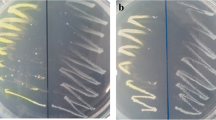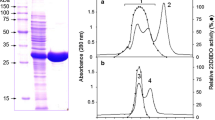Abstract
2,3-Dihydroxybiphenyl dioxygenase from Pseudomonas cepacia Et 4 was found to catalyze the ring fission of 2,3-dihydroxydiphenylether in the course of diphenylether degradation. The enzyme was purified and characterized. It had a molecular mass of 240 kDa and is dissociated by SDS into eight subunits of equal mass (31 kDa). The purified enzyme was found to be most active with 2,3-dihydroxybiphenyl as substrate and showed moderate activity with 2,3-dihydroxydiphenylether, catechol and some 3-substituted catechols. The K m-value of 1 μM for 2,3-dihydroxydiphenylether indicated a high affinity of the enzyme towards this substrate. The cleavage of 2,3-dihydroxydiphenylether by 2,3-dihydroxybiphenyl dioxygenase lead to the formation of phenol and 2-pyrone-6-carboxylate as products of ring fission and ether cleavage without participation of free intermediates. Isotope labeling experiments carried out with 18O2 and H2 18O indicated the incorporation of 18O from the atmosphere into the carboxyl residue as well as into the carbonyl oxygen of the lactone moiety of 2-pyrone-6-carboxylate. Based on these experimental findings the reaction mechanism for the formation of phenol and 2-pyrone-6-carboxylate is proposed in accordance with the mechanism suggested by Kersten et al. (1982).
Similar content being viewed by others
Abbreviations
- DPE:
-
diphenylether
- 2,3-dihydroxy-DPE:
-
2,3-dihydroxydiphenylether
- PCA:
-
2-pyrone-6-carboxylic acid
- 2,3-dihydroxy-BP dioxygenase:
-
2,3-dihydroxybiphenyl dioxygenase
- GC:
-
gas chromatography
References
Bernhardt FH, Ruf HH, Staudinger H, Ullrich V (1971) Purification of a 4-methylbenzoate O-demethylase from Pseudomonas putida. Hoppe-Seyler's Z Physiol Chem 352: 1091–1099
Bradford MM (1976) A rapid and sensitive methode for the quantitation of microgram quantities of protein utilizing the principle of protein-dye binding. Anal Biochem 72: 248–254
Cartwright NJ, Smith AW (1967) Bacterial attack on phenolic ethers. Biochem J 102: 826–841
Catelani D, Colombi A, Sorlini C, Treccani V (1973) Metabolism of biphenyl. 2-Hydroxy-6-oxo-6-phenylhexa-2,4-dienoate: the metacleavage product from 2,3-dihydroxybiphenyl by Pseudomonas putida. Biochem J 134: 1063–1066
Catelani D, Sorlini C, Treccani V (1971) The metabolism of biphenyl by Pseudomonas putida. Experientia 27: 1173–1174
Crosby DG, Wong AE (1977) Environmental degradation of 2,3,7,8-tetrachlorodibenzo-p-dioxin (TCDD). Science 195: 1337–1338
Duggleby CJ, Williams PA (1986) Purification and some properties of the 2-hydroxy-6-oxohepta-2,4-dienoate hydrolase (2-hydroxymuconic semialdehyde hydrolase) encoded by the TOL plasmid pWWO from Pseudomonas putida mt-2. J Gen Microbiol 132: 717–726
Engesser KH, Fietz W, Fischer P, Schulte P, Knackmuss HJ (1990) Dioxygenolytic cleavage of aryl ether bonds: 1,2-dihydro-1,2-dihydroxy-4-carboxyphenone as evidence for initial 1,2-dioxygenation in 3- and 4-carboxy biphenyl ether degradation FEMS Microbiol Lett 69: 317–322
Engesser KH, Strubel V, Christoglou K, Fischer P, Rast HG (1989) Dioxygenolytic cleavage of aryl ether bonds: 1,10-dihydro-1,10-dihydroxyfluren-9-one, a novel arene dihydrodiol as evidence for angular dioxygenation of dibenzofuran. FEMS Microbiol Lett 65: 205–210
Fortnagel P, Wittich RM, Harms H, Schmidt S (1989) New bacterial cleavage of the biaryl ether structure. Naturwissenschaften 76: 523–524
Fortnagel P, Harms H, Wittich RM, Krohn S, Meyer H, Sinnwell V, Wilkes H, Francke W (1990) Metabolism of dibenzofuran by Pseudomonas sp. strain HH69 and the mixed culture HH27. Appl Environ Microbiol 56: 1148–1156
Fujiwara M, Golovleva LA, Saeki Y, Nozaki M, Hayaichi O (1975) Extradiol cleavage of 3-substituted catechols by an intradiol dioxygenase, pyrocatechase, from a Pseudomonad. J Biol Chem 250: 4848–4855
Furukawa K, Arimura N (1987) Purification and properties of 2,3-dihydroxybiphenyl dioxygenase from polychlorinated biphenyl-degrading Pseudomonas pseudoalcaligenes and Pseudomonas aeruginosa carrying the cloned bphC gene. J Bacteriol 169: 924–927
Furukawa K, Matsumara F (1976) Microbial metabolism of polychlorinated biphenyls. Studies on the relative degradability of polychlorinated biphenyl components by Alcaligenes sp. J Agric Food Chem 42: 543–548
Furukawa K, Miyazaki T (1986) Cloning of a gene cluster encoding biphenyl and chlorobiphenyl degradation in Pseudomonas pseudoalcaligenes. J Bacteriol 166: 392–398
Furukawa K, Tomizuka N, Kamibayashi A (1979) Effects of chlorine substitution on the bacterial metabolism of various polychlorinated biphenyls. Appl Environ Microbiol 38: 301–310
Gamar Y, Gaunt JK (1971) Bacterial metabolism of 4-chloro-2-methylphenoxyacetate. Biochem J 122: 527–531
Gibson DT, Roberts RL, Wells MC, Kobal VM (1973) Oxidation of biphenyl by Beijerinckia species. Biochem Biophys Res Commun 50: 211–219
Hamilton GA (1974) Chemical models and mechanismsms for oxygenases. In: Hayaishi O (ed) Molecular mechanismsms of oxygen activation. Academic Press, New York, pp 405–451
Harms H, Wittich RM, Sinnwell V, Meyer H, Fortnagel P, Francke W (1990) Transformation of dibenzo-p-dioxin by Pseudomonas sp. strain HH69. Appl Environ Microbiol 56: 1157–1159
Heredy LA, Wender I (1980) Model structure for a bituminous coal. Am Chem Soc, Div Fuel Chem 25: 38–45
Ishigooka H, Yoshida Y, Omori T, Minoda Y (1986) Enzymatic dioxygenation of biphenyl-2,3-diol and 3-isopropylcatechol. Agric Biol Chem 50: 1045–1046
Kersten PJ, Chapman PJ, Dagley S (1985) Enzymatic release of halogens or methanol from substituted protocatechuic acids. J Bacteriol 162: 693–697
Kersten PJ, Dagley S, Whittaker JW, Arciero DM, Lipscomb JD (1982), 2-Pyrone-4,6-dicarboxylic acid, a catabolite of gallic acids in Pseudomonas species. J Bacteriol 152: 1154–1162
Klein J, Beyer B, vanAfferden M, Hodek W, Pfeifer F, Seewald H, Wolff-Fischer E, Jüntgen H (1988) Coal in biotechnology. In: Rehm H-J, Reed G (eds) Biotechnology, vol 6b. Verlag Chemie, Weinheim, pp 497–567
Laemmli UK (1970) Cleavage of structural proteins during the assembly of the head of bacteriophage T4. Nature 227: 680–685
Liepins R, Pearse EM (1976) Chemistry and toxicity of flame retardants for plastics. Environ Health Perspect 17: 55–63
Lipscomb JD, Whittaker JW, Arciero DM, Orville AM, Wolgel SA (1988) Mechanisms of catecholic dioxygenases. In: Hagedorn SR, Hanson RS, Kunz DA (eds) Microbial metabolism and the carbon cycle. Harwood Academic Publishers, New York, pp 259–281
Nozaki M (1970) Metapyrocatechase (Pseudomonads). Methods enzymol 17A: 522–525
Patel TR, Barnsley EA (1980) Naphthalene metabolism by Pseudomonads: Purification and properties of 1,2-dihydroxynaphthalene oxygenase. J Bacteriol 143: 668–673
Pfeifer F, Schacht S, Klein J, Trüper HG (1989) Degradation of diphenylether by Pseudomonas cepacia. Arch Microbiol 152: 515–519
Pieper HP, Reineke W, Engesser KH, Knackmuss HJ (1988) Metabolism of 2,4-dichlorophenoxyacetic acid, 4-chloro-2-methylphenoxyacetic acid and 2-methylphenoxyacetic acid by Alcaligenes eutrophus JMP 134. Arch Microbiol 150: 95–102
Ribbons DW (1970) Stoichiometry of 3-O-demethylase activity in Pseudomonas aeruginosa. FEBS Lett 8: 101–104
Saeki YS, Nozaki M, Senoh S (1980) Cleavage of pyrogallol by nonheme iron-containing dioxygenases. J Biol Chem 255: 8465–8471
Tack BF, Chapman PJ, Dagley S (1972) Metabolism of gallic acid and syringic acid by Pseudomonas putida. J Biol Chem 247: 6438–6443
Taira K, Hayase N, Arimura N, Yamashita S, Miyazaki T, Furukawa K (1988) Cloning and nucleotide sequence of the 2,3-dihydroxybiphenyl dioxygenase gene from the PCB-degrading strain of Pseudomonas paucimobilis Q1. Biochemistry 27: 3990–3996
Tulp MT, Sundström G, Martron BJM, Hutzinger W (1979) Metabolism of chlorodiphenyl ethers and Irgasan DP300. Xenobiotica 9: 65–77
Weber K, Osborn M (1969) The reliability of molecular weight determination by dodecylsufate-polyacrylamid gelelectrophoresis. J Biol Chem 244: 4406–4412
Weissenfels WD, Beyer M, Klein J, Rehm HJ (1991) Microbial metabolism of fluoranthene: isolation and identification of ring fission products. Appl Microbiol Biotechnol 34: 528–535
Author information
Authors and Affiliations
Rights and permissions
About this article
Cite this article
Pfeifer, F., Trüper, H.G., Klein, J. et al. Degradation of diphenylether by Pseudomonas cepacia Et4: enzymatic release of phenol from 2,3-dihydroxydiphenylether. Arch. Microbiol. 159, 323–329 (1993). https://doi.org/10.1007/BF00290914
Received:
Accepted:
Issue Date:
DOI: https://doi.org/10.1007/BF00290914




